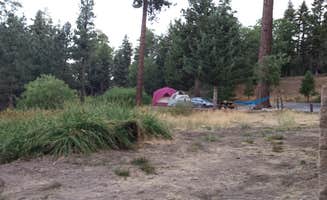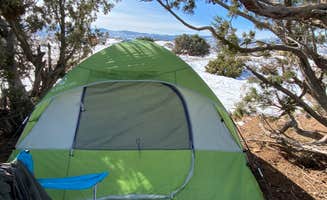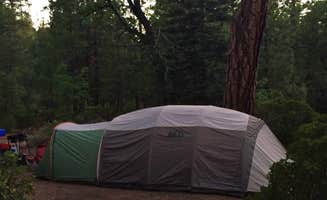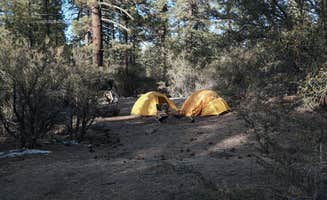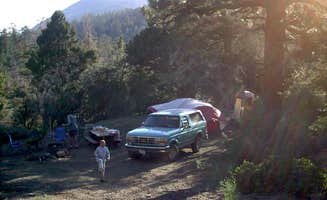Dispersed camping opportunities abound in the San Bernardino National Forest near Running Springs, California, at elevations between 6,000 and 8,000 feet. The mountainous terrain offers access to mixed conifer forests dominated by Jeffrey pine, white fir, and incense cedar. Winter temperatures often drop below freezing with snow possible from November through April, while summer days typically range from 70-85°F.
What to Do
Hiking to panoramic viewpoints: The area surrounding Limber Pine Bench Campground connects to the San Bernardino Peak trail system. "It's not too far, and the hill isn't too steep, but it is a 9000ft elevation, so it's a bit of work. Well worth it though, and a fun place to stay," notes Daniel J.
Fishing in nearby lakes: Green Valley Lake, located within a mile of Lake Arrowhead - Green Valley Lake Recreation Area, provides fishing opportunities. "Good lake for fishing. Trails near the sites. There are some great views as you hike up the mountain," reports Stephen S.
Off-highway vehicle exploration: Forest roads throughout the area offer extensive OHV access from Big Pine Flat Campground. "Big Pines Flats is set right next to a meadow at a forest crossing heading to Holcomb Valley, Victorville, Fawnskin, and Green Valley Lake. There are shooting ranges, OHV trails, Jeep trails, hiking, you name it," explains Mike M.
What Campers Like
Secluded tent camping spots: Tent camping near Running Springs often means finding hidden spots away from crowds. "I really dig these spots because they are well spaced out. It's right around the corner from my cabin so it's a great spot to get outside for the weekend without an epic drive," mentions Lynn C. about Keller Peak Yellow Post Campsites.
Natural water features: Streams and small lakes enhance the camping experience. "My husband and I did our camping trip for the weekend here! Beautiful, private, and secluded. The campgrounds were wonderful- fair warning only a few campsites have a fire pit," notes Katie S. about Thomas Hunting Grounds Yellow Post Sites.
Abundant wildlife viewing: The forested environment supports diverse animal populations. "Quiet and (mostly) clean sites. Tons of land to hike, on or off trail. Geocaching sites nearby," reports Steve H. who appreciated the natural surroundings at Keller Peak.
What You Should Know
Vehicle requirements: Many dispersed camping areas require appropriate transportation. "You definitely need a high clearance vehicle. There are campgrounds in the area and also yellow post campsites. There wasn't many other vehicles around the times I've been out there," advises Edward W. about Holcomb Valley Climbers Camp.
Weather considerations: Mountain weather can change rapidly, requiring proper preparation. "We went in April, and still had a little bit of snow. All the trail roads are mostly for 4 x 4 vehicles that really enjoy just going at it throughout the day," explains Seth B. about Holcomb Valley.
Varying amenities: Services differ widely between established campgrounds and dispersed sites. "Excellent campground. Well maintained. Large concrete pads that can handle any rig. So much to do all around a park. Does get very cold, was in the teens overnight when I was there in Feb," shares Paul C. about Yucaipa Regional Park.
Tips for Camping with Families
Lake activities for kids: Several nearby recreational areas offer family-friendly water features. "The newer sites don't have a lot of mature trees, the older sites have a little more wear and tear but also bigger trees. Nice splash zone," mentions Ken B. about Yucaipa Regional Park.
Multi-generational camping spots: Some campgrounds better accommodate varied age groups. "It's a lot of fun for the whole family. A fun place to be if you live local. A good place to go if you like to be around other people," shares Katarina A. about Yucaipa Regional Park.
Educational opportunities: Forest exploration provides learning experiences. "The Keller Peak Lookout was amazing. I thought it was just a tourist attraction but it's really a staffed (with volunteers) active fire lookout. Worth the trip for sure," recommends Steve H.
Tips from RVers
Small RV access limitations: Larger vehicles face challenges on forest roads. "The road up to the camp area is a bit rough. We were in a Sprinter and definitely nervous for parts. But, it was worth it once we got there! It's secluded and has enough trees for a hammock," notes Allie N. about Holcomb Valley Climbers Camp.
Winter camping preparations: Cold-weather RV camping requires additional planning. "Most private RV spots discriminate against Skoolies, but this place didn't seem to care. Good water pressure in the showers, which has been nice," explains Jason O. about Yucaipa Regional Park.
Site selection strategy: Research helps identify the best spots for RVs. "Great free camping when campgrounds are booked. Easy to navigate with GPS. Many large and small sites along the road. Some spots more secluded than others. Smaller rigs, medium clearance and lite off-road capabilities recommended," advises Dickie Simmons S. about Mill Creek Dispersed Camping.



